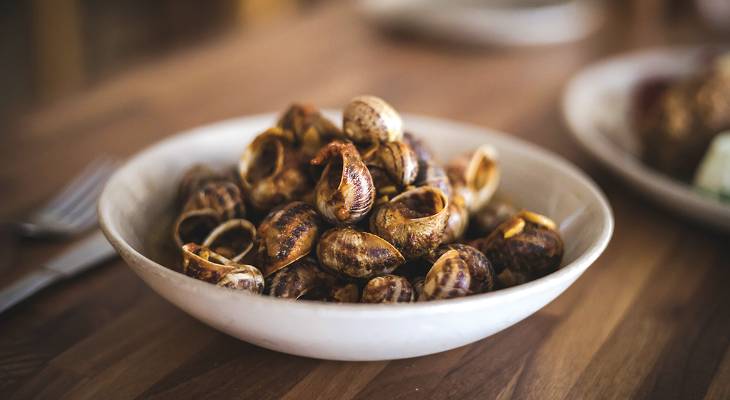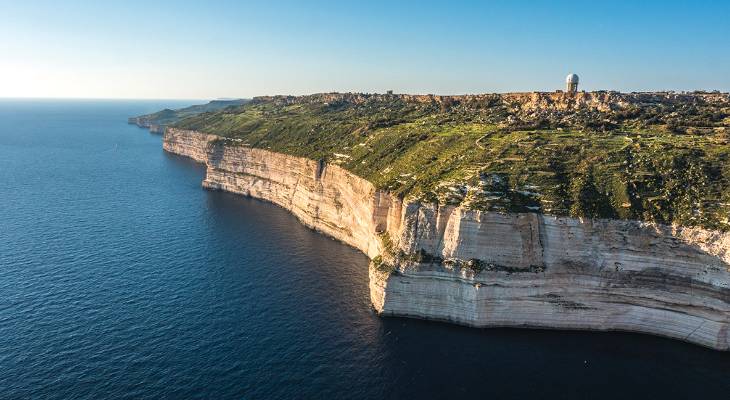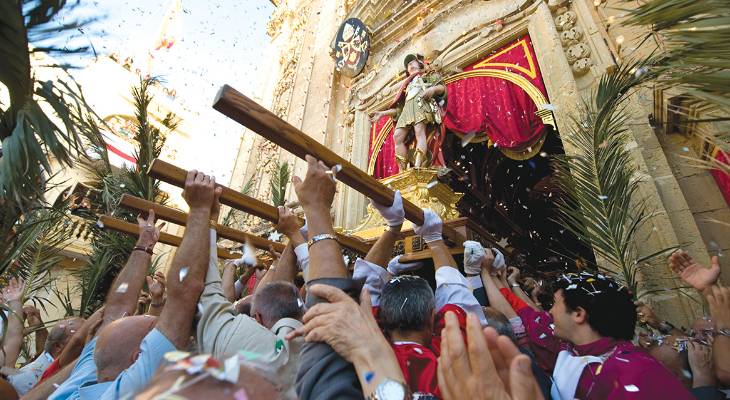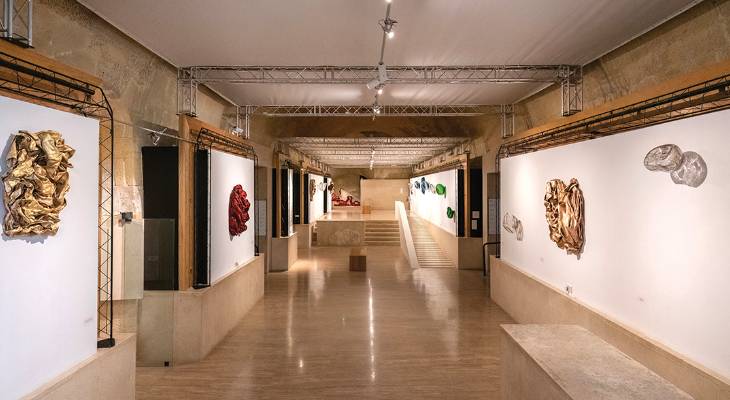Malta may be tiny, but it’s jam-packed with experiences and adventures for all travellers to enjoy, whether you’re a history buff, sun worshipper, foodie, culture lover, or thrill-seeker.
1. Head on an epic diving adventure
Malta is a top diving destination, offering an ideal setting for divers of all skill levels. Thanks to the islands’ warm climate, diving is possible for much of the year, with optimal conditions typically experienced from June to September. There are also plenty of reputable diving academies to choose from, ensuring safe and enjoyable experiences.
Finger Reef at Ghar Lapsi is ideal for beginners, thanks to its shallow depths and naturally lit cave system. For a more immersive experience, venture to the secluded Santa Maria Caves in Comino, where scenic caves and swim-throughs beneath the cliffs await exploration. Dive deeper into adventure at Gozo’s famed Blue Hole, a deep sinkhole populated with vibrant coral and teeming with marine life, located near the majestic Azure Alps, a jaw-dropping mountain-like topography that was once the site of the Azure Window.
Beyond many natural sites, there’s a healthy smattering of sunken ships and aircraft wrecks to discover. The Blenheim Bomber, P31 minesweeper, MV Karwela ferry boat, and the 115m-long Um El Faroud oil tanker are just some of the fascinating underwater wrecks to be explored.
2. Feast on Maltese flavours
Despite drawing influences from Italy, particularly Sicily, as well as North Africa, Britain, and France, Maltese cuisine has an altogether distinct character, favouring simple ingredients for robust, rustic flavours.
A must-try is pastizzi, a flaky pastry traditionally filled with either creamy ricotta cheese or mushy peas. These tasty treats can be found in many hole-in-the-wall pastizzeriji scattered across the islands. Another beloved option is the ftira, a circular bread filled with kunserva (a sweet local tomato paste) and an array of toppings including tuna, olives, capers, and gbejniet (local cheese).
For heartier fare, seek out lampuki in Marsaxlokk. This dorado fish is best enjoyed between mid-August and December when it’s in season. Fried or grilled in tinfoil with a light seasoning, this tender fish pairs perfectly with crusty Maltese bread. The fishing village of Marsaxlokk, with its promenade lined with seafood restaurants, is your best bet to savour this national delicacy.

Inigo Taylor
Finally, no visit to Malta is complete without experiencing a fenkata (a rabbit-focused meal) in the small village of Mgarr. Fenek (rabbit) is a much-loved national dish, fried in garlic or marinated in wine and stewed with aromatic herbs and vegetables until it’s melt-in-your-mouth delicious. For the adventurous palate, look out for traditional appetizers like laham taz-ziemel (horse meat) and bebbux bl-aljoli (snails served with a rich herby sauce).
3. Taste Malta’s Michelin magic
The Michelin Guide may have only arrived in Malta in 2020, but the island has swiftly become a haven for world-class dining experiences.
As of 2024, the Michelin Guide Malta features a selection of 40 restaurants spread across Malta and Gozo, promising numerous incredible dining options to treat yourself to during your visit. Among them, seven boast coveted Michelin stars, while five have earned the esteemed bib gourmand distinction, which recognises exceptional cuisine at great value.
ION Harbour by Simon Rogan in Valletta is Malta’s very first two-Michelin star recipient. Joining the ranks of distinguished one-starred restaurants is Rosami at The Villa, which now stands alongside other renowned establishments, namely Bahia, Fernandõ Gastrotheque, De Mondion, Under Grain, and Noni. These restaurants continue to dazzle diners with their exquisite offerings, innovative dishes and meticulously curated wine cellars.
4. Step into centuries of history
From prehistoric settlements to the rule of the Arabs, the Roman empire, the Order of the Knights of St John, and later, the French and British, Malta has a wealth of heritage steeped in history. With so much to explore, including many UNESCO World Heritage sites, selecting the highlights can be a challenge.
Valletta is always a great place to start. Inside the fortified capital built by the Knights, you can explore the majestic Grand Master’s Palace, marvel at the Baroque splendour of St John’s Co-Cathedral and discover the treasures inside the National Museum of Archaeology. Don’t miss Underground Valletta, a 500-year-old labyrinth that sheltered the Maltese during World War II bombings. Once you’ve exhausted Valletta, catch a ferry to the Three Cities to explore Fort St Angelo, the Inquisitor’s Palace and the Malta Maritime Museum, among other sites that offer a deeper understanding of Malta’s rich heritage.
Neighbouring Mdina and Rabat offer a perfect duo for a fascinating day trip. Begin your journey by exploring St Paul’s Grotto, where legend has it that the saint lived after being shipwrecked in Malta. Then, delve deeper into history at the Domvs Romana, which offers a glimpse into life under Roman rule. The site is built atop the remains of a Roman villa dating back to the 1st century BC, shedding light on the private life and habits of an ancient Roman aristocrat.
Once you pass through Mdina’s moated gate, a treasure trove of attractions awaits, including the National Museum of Natural History, The Metropolitan Cathedral of St Paul and its museum, the Carmelite Priory, and numerous architectural wonders.
Malta is also home to some of the world’s oldest man-made structures. Hagar Qim and Mnajdra are bucket-list sites, especially during a solstice when the sun casts its rays directly through their portals at sunrise. It’s an awe-inspiring spectacle. For more prehistoric marvels, don’t miss the Ggantija Archaeological Park in Gozo and the Hal Saflieni Hypogeum in Paola, a subterranean necropolis with interconnected halls and chambers carved from solid rock.
5. Go rural with a countryside escapade
There’s also a rich countryside to explore within the archipelago. From the shaded woodlands of Buskett Gardens and the dramatic views from Dingli Cliffs to the rural valleys of Manikata and the emerald hills around Gozo, there’s no shortage of scenic trails for leisurely hikes.

viewingmalta.com
One of the best treks for hikers of all abilities to enjoy can be found in Mellieha. Starting from Ghadira Bay, work your way up to the small, protected woodlands of Foresta 2000, home to various indigenous trees, including the Aleppo pine, holm oak and carob tree. Well-trodden paths in the area will lead you up towards the easy-to-spot Red Tower, a bastioned watch tower built in the 17th century. Continuing onward towards the Radar Station, you’ll soon spot pathways which lead you towards Rdum il-Qammieh clifftops. From here, you can walk right down to the limestone coast scattered with fossilised seashells. This stretch of coastline is among the most secluded on the island, ensuring you won’t encounter many people except for a few fishermen seeking peace and quiet.
6. Experience the spectacle of Malta’s religious feasts
A deeply Catholic country, Malta and Gozo celebrate holy days and parish feasts with a fervent passion. Easter Week is observed with solemnity and devotion. From Palm Sunday to Easter Sunday, many villages host processions along streets adorned with beautiful decorations. Good Friday sees dramatic re-enactments of Christ’s Passion, sometimes with hundreds of locals in Biblical attire parading through the streets while marching bands play sombre tunes. In contrast, Easter Sunday bursts with jubilation as church bells ring out and streets buzz with excitement as groups of men carry the statue of the Risen Christ around the village.

viewingmalta.com
Malta’s festa season, which mostly unfolds throughout the summer, is an experience not to be missed. Each festa honours the patron saint of its parish, with week-long festivities leading up to the main feast day. Churches are adorned with elaborate religious decorations, inside and out, while streets are festooned with coloured lights and banners. The eve of the feast day dazzles with boisterous marching band parades, kaleidoscopic fireworks and Catherine Wheels illuminating the night. With at least one festa happening every week in summer, be sure to check local calendars for the next village celebration and join in the lively festivities.
7. Treat yourself to some beachfront bliss
No trip to Malta is complete without experiencing its azure seas. Whether you’re up for a leisurely swim, an exciting snorkelling expedition, a scenic boat ride, or thrilling water sports, the possibilities are endless.
Top picks for beach lovers include family-friendly Ghadira Bay in Mellieha, with its shallow waters, and the Blue Flag Golden Bay. For a swimming spot with a difference, head to St Peter’s Pool near Marsaxlokk. Set amidst limestone rocks, it makes for fun leaping and diving into the deep waters below. There are also plenty of fantastic rocky beaches in Sliema, including Exiles Beach and Tigné Point, where you can enjoy a unique swim with panoramic views of Valletta sprawling before you.
On Gozo, the reddish sands of Ramla l-Hamra continue to draw visitors, while the golden shores of San Blas Bay are another haven for sunseekers. And don’t miss a visit to Comino’s Blue Lagoon, a paradise of powder-soft sands and crystal-clear waters. Word to the wise: head there extra early to beat the crowds at the height of summer.
Explore Malta’s seas further with a boat trip to the enchanting Blue Grotto, passing by other sea caves like Honeymoon Cave and Cat’s Cave. For a historic voyage, embark on a Grand Harbour cruise on a dghajsa tal-pass (traditional Maltese boat) and admire Valletta’s majestic forts and bastions right from the water. And for an extra touch of luxury, why not charter a private yacht and sail to Malta’s most secluded and stunning coastal spots in style?
8. Ignite your imagination with Malta’s art scene
Start your art journey at MUŻA, the National Community Art Museum, on Merchants Street in Valletta. Here, you’ll discover an inspiring collection of paintings, sculptures and other objets d’art showcasing works by renowned Maltese artists like Edward Caruana Dingli and Emvin Cremona, alongside pieces by international talents.
For lovers of contemporary art, Spazju Kreattiv in Valletta is a great stop. This cultural hub hosts a revolving calendar of temporary exhibitions and installations, usually featuring boundary-pushing and thought-provoking creations from both local and international artists.

If you’ve recently binged the hit Netflix series ‘Ripley’ and are intrigued by the dramatic works of Italian painter Caravaggio, Malta has got you covered. Marvel at two of his iconic paintings, including what is generally considered one of his finest masterpieces ‘The Beheading of St John the Baptist’, displayed in the Oratory of St John’s Co-Cathedral in Valletta.
While here, don’t miss the opportunity to admire the sublime, vaulted ceiling painting by Calabrian artist Mattia Preti, depicting the life of St John, as well as several altar paintings executed by him. You can explore more of Preti’s Baroque works at numerous churches around the island.
The article first appeared on Malta Insider 2024/2025.
Which activity would you go for first?